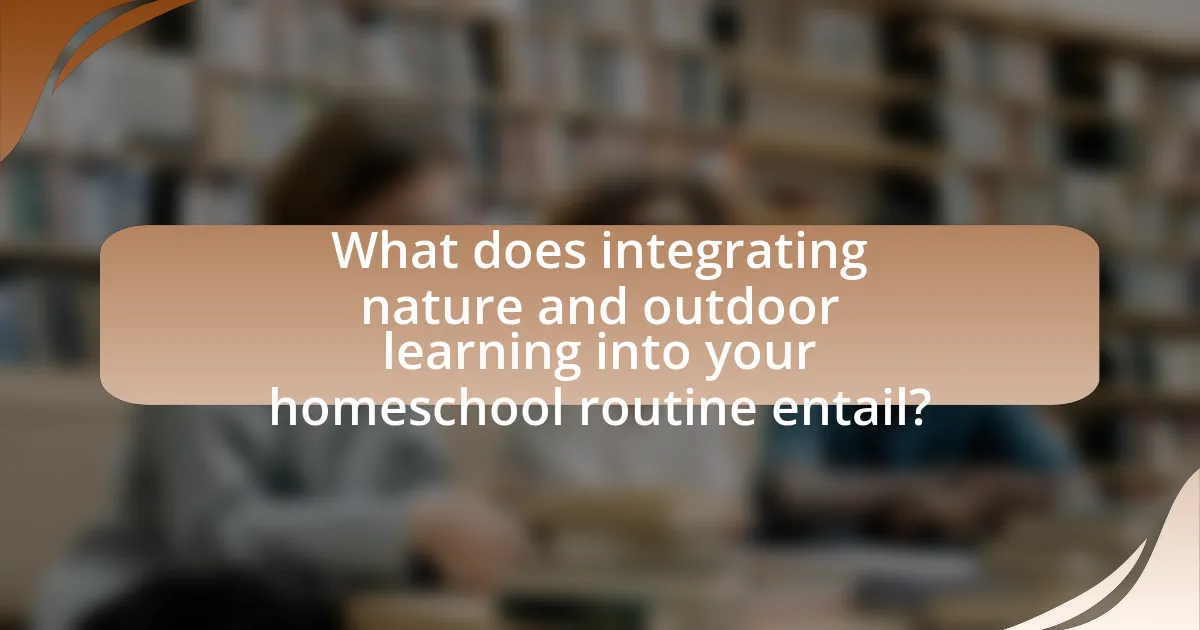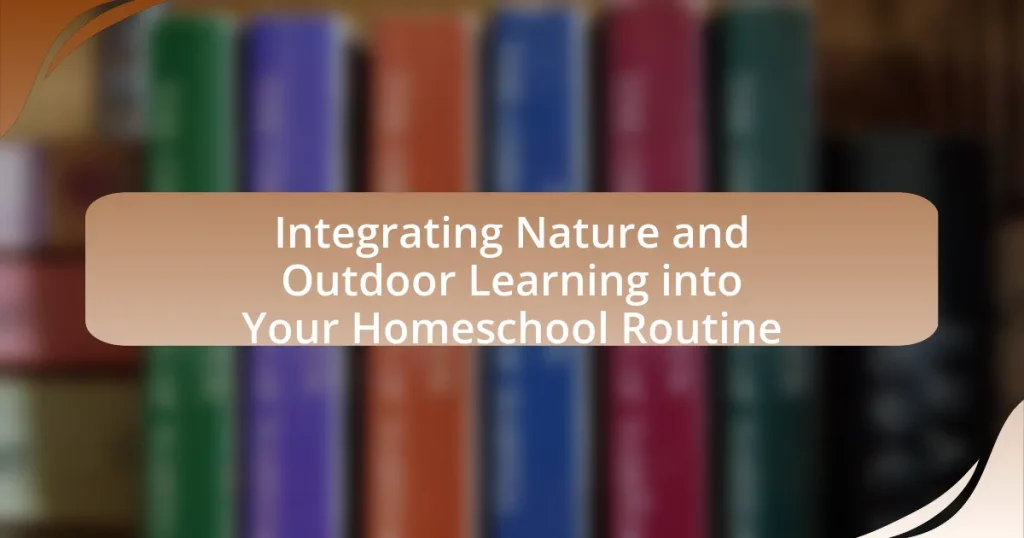Integrating nature and outdoor learning into homeschooling involves hands-on experiences in natural settings, such as nature walks, gardening, and outdoor experiments, which enhance educational outcomes and foster a connection with the environment. This approach supports various learning styles, improves academic performance, and promotes physical and emotional well-being. Key principles include experiential learning, connection to nature, and interdisciplinary approaches, while practical strategies for implementation involve planning outdoor activities, utilizing local ecosystems, and leveraging technology. The article also addresses challenges in outdoor learning integration and offers tips for successful engagement in nature-based activities.

What does integrating nature and outdoor learning into your homeschool routine entail?
Integrating nature and outdoor learning into your homeschool routine entails incorporating hands-on experiences in natural settings to enhance educational outcomes. This approach involves activities such as nature walks, gardening, outdoor science experiments, and wildlife observation, which promote experiential learning and foster a connection with the environment. Research indicates that outdoor learning can improve student engagement and retention of information, as evidenced by a study published in the Journal of Environmental Education, which found that students participating in outdoor education programs demonstrated higher academic performance and increased motivation compared to traditional classroom settings.
How can nature and outdoor learning enhance the homeschooling experience?
Nature and outdoor learning can significantly enhance the homeschooling experience by providing hands-on, experiential learning opportunities that engage students in real-world contexts. Engaging with nature fosters curiosity and promotes critical thinking skills, as children observe and interact with their environment. Research indicates that outdoor learning can improve academic performance; for instance, a study published in the Journal of Environmental Education found that students who participated in outdoor education programs showed higher test scores in science and math compared to their peers in traditional classroom settings. Additionally, outdoor activities contribute to physical health and well-being, which are essential for effective learning. Thus, integrating nature and outdoor learning into homeschooling not only enriches the educational experience but also supports holistic development.
What are the key principles of outdoor learning?
The key principles of outdoor learning include experiential learning, connection to nature, and interdisciplinary approaches. Experiential learning emphasizes hands-on experiences that engage learners directly with their environment, fostering deeper understanding and retention of knowledge. Connection to nature highlights the importance of fostering a relationship between learners and the natural world, which can enhance well-being and environmental stewardship. Interdisciplinary approaches integrate various subjects, such as science, art, and physical education, allowing learners to explore concepts in a holistic manner. These principles are supported by research indicating that outdoor learning can improve academic performance, social skills, and emotional resilience.
How does outdoor learning support various learning styles?
Outdoor learning supports various learning styles by providing experiential, hands-on opportunities that cater to visual, auditory, and kinesthetic learners. For instance, visual learners benefit from observing natural environments, while auditory learners engage through listening to sounds of nature and discussions. Kinesthetic learners thrive in outdoor settings where they can physically interact with their surroundings, such as through gardening or exploring ecosystems. Research by the University of Illinois found that outdoor learning enhances engagement and retention, demonstrating that students who participate in outdoor education show improved academic performance and social skills. This evidence underscores the effectiveness of outdoor learning in addressing diverse educational needs.
Why is it important to include nature in education?
Including nature in education is important because it enhances cognitive development and promotes emotional well-being. Research indicates that exposure to natural environments can improve attention, creativity, and problem-solving skills in students. A study published in the journal “Frontiers in Psychology” by authors Frances E. Kuo and Andrea Faber Taylor found that children who engage with nature exhibit better focus and reduced symptoms of attention deficit hyperactivity disorder (ADHD). Furthermore, outdoor learning experiences foster a sense of connection to the environment, encouraging stewardship and sustainability. This holistic approach to education not only enriches academic learning but also nurtures social and emotional growth.
What benefits does nature exposure provide for children’s development?
Nature exposure significantly benefits children’s development by enhancing their cognitive, emotional, and physical growth. Research indicates that children who spend time in natural environments exhibit improved attention spans, creativity, and problem-solving skills. A study published in the journal “Environmental Science & Technology” found that children with regular access to green spaces show reduced symptoms of attention deficit hyperactivity disorder (ADHD), highlighting the positive impact of nature on focus and behavior. Additionally, outdoor play fosters social skills and emotional resilience, as children learn to navigate challenges and collaborate with peers in a natural setting. Overall, nature exposure is crucial for holistic child development, supported by empirical evidence linking outdoor experiences to various developmental advantages.
How does nature impact mental health and well-being in children?
Nature positively impacts mental health and well-being in children by reducing stress, enhancing mood, and improving cognitive function. Research indicates that exposure to natural environments can lower levels of cortisol, a stress hormone, and increase feelings of happiness and relaxation. A study published in the journal “Environmental Science & Technology” found that children who spend time in green spaces exhibit lower levels of attention deficit hyperactivity disorder (ADHD) symptoms. Additionally, outdoor activities promote physical health, which is closely linked to mental well-being, as physical exercise releases endorphins that improve mood. Thus, integrating nature into children’s routines fosters both emotional and psychological benefits.

What practical strategies can be used to integrate nature into homeschooling?
Practical strategies to integrate nature into homeschooling include outdoor learning activities, nature journaling, and hands-on science experiments. Engaging in outdoor learning activities, such as nature walks or gardening, allows students to explore ecosystems and observe wildlife directly, enhancing their understanding of biology and environmental science. Nature journaling encourages students to document their observations, fostering creativity and critical thinking while reinforcing writing skills. Additionally, hands-on science experiments, like soil testing or plant growth studies, provide concrete experiences that illustrate scientific concepts. Research indicates that outdoor learning can improve student engagement and retention of information, making these strategies effective for homeschooling.
How can parents effectively plan outdoor learning activities?
Parents can effectively plan outdoor learning activities by identifying educational goals, selecting appropriate locations, and incorporating hands-on experiences. First, parents should define specific learning objectives, such as enhancing knowledge in science, geography, or environmental studies. Next, they can choose suitable outdoor settings like parks, nature reserves, or botanical gardens that align with these goals. For instance, a visit to a local nature reserve can provide opportunities for studying ecosystems and biodiversity. Finally, parents should design activities that encourage exploration and interaction, such as nature scavenger hunts or observational journaling, which have been shown to enhance engagement and retention of knowledge in outdoor settings.
What types of outdoor activities are suitable for different age groups?
Outdoor activities suitable for different age groups include nature walks for toddlers, scavenger hunts for preschoolers, hiking for school-aged children, and camping for teenagers. Toddlers benefit from simple nature walks that enhance sensory exploration, while preschoolers enjoy scavenger hunts that promote observation skills. School-aged children can engage in hiking, which builds endurance and appreciation for nature, and teenagers often find camping appealing as it fosters independence and teamwork. These activities align with developmental milestones and encourage physical fitness, social interaction, and environmental awareness.
How can parents incorporate local ecosystems into their lessons?
Parents can incorporate local ecosystems into their lessons by organizing field trips to nearby parks, nature reserves, or wetlands, where children can observe and study native plants and wildlife. Engaging in hands-on activities, such as collecting soil samples or identifying local flora and fauna, allows children to connect theoretical knowledge with real-world experiences. Research indicates that experiential learning in natural settings enhances understanding of ecological concepts, as demonstrated in studies by the National Environmental Education Foundation, which show that outdoor education improves student engagement and retention of information.
What resources are available for outdoor learning?
Resources available for outdoor learning include nature-based curricula, educational programs, and community partnerships. Nature-based curricula, such as Project Learning Tree and the Outdoor Classroom Project, provide structured activities that integrate environmental education with hands-on experiences. Educational programs offered by organizations like the National Park Service and local nature centers often include guided field trips, workshops, and volunteer opportunities that enhance outdoor learning. Additionally, community partnerships with local schools, environmental organizations, and outdoor recreation groups can provide access to resources, expertise, and collaborative learning experiences, fostering a rich outdoor learning environment.
Which books and materials can support nature-based education?
Books and materials that can support nature-based education include “Last Child in the Woods” by Richard Louv, which discusses the importance of nature for children’s development, and “The Nature Principle,” also by Louv, which emphasizes the benefits of connecting with nature. Additionally, “The Wildwood Way” by Ben Law provides practical guidance on engaging with the natural world through hands-on activities. Resources like the “Nature Study” curriculum from the Homeschool Buyers Co-op offer structured learning experiences focused on outdoor exploration. These materials are validated by research indicating that nature-based education enhances cognitive, emotional, and social development in children.
How can technology enhance outdoor learning experiences?
Technology can enhance outdoor learning experiences by providing interactive tools that facilitate real-time data collection and analysis. For instance, mobile applications enable students to identify plant species, track weather patterns, and record wildlife observations, thereby deepening their understanding of ecological systems. Research shows that using technology in outdoor settings can increase student engagement and retention of information, as evidenced by a study published in the Journal of Educational Technology & Society, which found that students using digital tools in nature-based learning scored 20% higher on assessments compared to those who did not. This integration of technology not only enriches the learning experience but also fosters critical thinking and problem-solving skills in real-world contexts.

What challenges might arise when integrating nature into homeschooling?
Integrating nature into homeschooling can present challenges such as limited access to natural environments, safety concerns, and curriculum alignment. Limited access occurs when families live in urban areas with few green spaces, making it difficult to engage in outdoor learning. Safety concerns arise from potential hazards in natural settings, which may deter parents from allowing their children to explore freely. Additionally, aligning nature-based activities with educational standards can be complex, as parents may struggle to incorporate these experiences into a structured curriculum effectively. These challenges can hinder the successful integration of nature into homeschooling practices.
How can parents overcome common obstacles to outdoor learning?
Parents can overcome common obstacles to outdoor learning by establishing a structured routine that incorporates outdoor activities into their homeschooling schedule. This approach helps to prioritize outdoor learning, making it a regular part of the educational experience rather than an occasional activity. Research indicates that children benefit from outdoor learning environments, which enhance engagement and retention of information. For instance, a study published in the Journal of Environmental Education found that students who participated in outdoor learning showed a 27% increase in science knowledge compared to those who learned in traditional classroom settings. By setting specific times for outdoor exploration and integrating subjects like science and art into these activities, parents can effectively address barriers such as time constraints and lack of resources.
What safety considerations should be taken into account during outdoor activities?
Safety considerations during outdoor activities include assessing environmental hazards, ensuring proper equipment usage, and maintaining awareness of weather conditions. Environmental hazards such as uneven terrain, wildlife encounters, and poisonous plants can pose risks, necessitating a thorough evaluation of the area before engaging in activities. Proper equipment, including helmets for biking or climbing gear for hiking, is essential to prevent injuries. Additionally, awareness of weather conditions is crucial; for instance, extreme temperatures or sudden storms can lead to dangerous situations. According to the National Safety Council, outdoor activities account for a significant number of injuries each year, highlighting the importance of these safety measures.
How can weather conditions affect outdoor learning plans?
Weather conditions can significantly impact outdoor learning plans by influencing safety, engagement, and the feasibility of activities. For instance, extreme temperatures can pose health risks, leading to the cancellation or modification of outdoor lessons. Rain or snow can create hazardous conditions, making outdoor spaces unsafe for students. Additionally, adverse weather can reduce student motivation and focus, as discomfort may distract from learning objectives. Research indicates that outdoor learning is most effective in mild, pleasant weather, which enhances student participation and retention of information. Therefore, educators must consider weather forecasts and adapt their plans accordingly to ensure a safe and productive outdoor learning environment.
What are some tips for successful outdoor learning integration?
Successful outdoor learning integration involves creating structured, engaging activities that connect curriculum objectives with nature. To achieve this, educators should plan lessons that utilize the outdoor environment as a classroom, ensuring that activities are aligned with educational standards. For instance, incorporating hands-on experiments in a garden can enhance understanding of biology concepts, as supported by studies showing that outdoor learning increases student engagement and retention of information. Additionally, fostering a sense of exploration and curiosity in students encourages them to ask questions and seek answers in a natural setting, which has been linked to improved critical thinking skills.
How can parents create a flexible outdoor learning schedule?
Parents can create a flexible outdoor learning schedule by incorporating varied activities that align with their children’s interests and educational goals. This can be achieved by planning outdoor lessons that can be adjusted based on weather conditions, time availability, and children’s engagement levels. For instance, parents can designate specific days for nature walks, gardening, or outdoor science experiments, allowing for spontaneous adjustments as needed. Research indicates that outdoor learning enhances children’s cognitive and emotional development, making it a valuable component of homeschooling. By maintaining a balance between structured activities and free exploration, parents can foster a dynamic learning environment that adapts to their family’s needs.
What are best practices for engaging children in nature-based activities?
Best practices for engaging children in nature-based activities include hands-on exploration, fostering curiosity, and incorporating play. Engaging children through hands-on exploration allows them to interact directly with their environment, which enhances learning and retention. Fostering curiosity by encouraging questions and providing opportunities for discovery promotes a deeper connection to nature. Incorporating play into these activities, such as scavenger hunts or nature games, makes the experience enjoyable and memorable. Research indicates that children who regularly engage in nature-based activities exhibit improved cognitive function and emotional well-being, highlighting the effectiveness of these practices.










